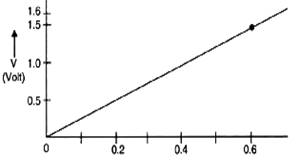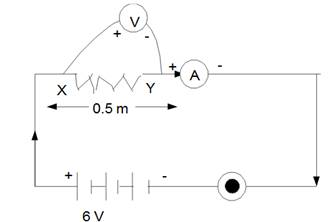An electric circuit consisting of a 0.5 m long nichrome wire XY, an ammeter, a voltmeter, four cells of 1.5 V each and a plug key was set up.
(i) Draw a diagram of this electric circuit to study the relation between the potential difference maintained between the points 'X' and 'Y' and the electric current flowing through XY.
(ii) Following graph was plotted between V and I values:

What would be the value of ![]() ratios when the potential differences us 0.8 V, 1.2 V and 1.6 V respectively?
ratios when the potential differences us 0.8 V, 1.2 V and 1.6 V respectively?
What conclusion does you drawn from the values?
(iii) What is the resistance of the wire?
(i) 
(ii) From graph we find that current values corresponding to potential difference of 0.8V, 1.2V and 1.6V respectively are 0.3 A, 0.45A and 0.6A.
![]()
![]()
![]()
![]()
From these values we conclude that ration V/I is a constant i.e., V α I. It means that Ohm’s law is being followed.
(iii) The resistance of the wire is equal to the ratio of potential difference applied and the current passing through it.
![]()